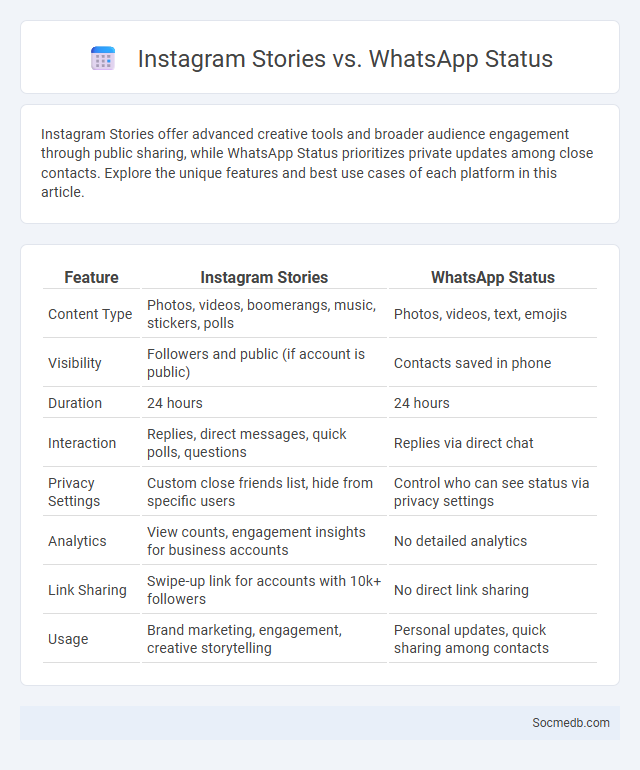
Photo illustration: Instagram Stories vs Whatsapp Status
Instagram Stories offer advanced creative tools and broader audience engagement through public sharing, while WhatsApp Status prioritizes private updates among close contacts. Explore the unique features and best use cases of each platform in this article.
Table of Comparison
| Feature | Instagram Stories | WhatsApp Status |
|---|---|---|
| Content Type | Photos, videos, boomerangs, music, stickers, polls | Photos, videos, text, emojis |
| Visibility | Followers and public (if account is public) | Contacts saved in phone |
| Duration | 24 hours | 24 hours |
| Interaction | Replies, direct messages, quick polls, questions | Replies via direct chat |
| Privacy Settings | Custom close friends list, hide from specific users | Control who can see status via privacy settings |
| Analytics | View counts, engagement insights for business accounts | No detailed analytics |
| Link Sharing | Swipe-up link for accounts with 10k+ followers | No direct link sharing |
| Usage | Brand marketing, engagement, creative storytelling | Personal updates, quick sharing among contacts |
Introduction to Social Media Stories
Social Media Stories are ephemeral content formats designed to boost engagement by offering users quick, visual updates that disappear after 24 hours. Platforms like Instagram, Snapchat, and Facebook have popularized Stories, allowing brands and individuals to share real-time moments without cluttering their main feed. This format fosters authentic interactions, driving increased user participation and brand visibility in highly competitive digital landscapes.
What Are Instagram Stories?
Instagram Stories are short, temporary photo or video posts that disappear after 24 hours, allowing users to share moments in a more casual and immediate way. These stories can include stickers, text, filters, and interactive elements like polls or questions to engage your audience effectively. Perfect for real-time updates, Instagram Stories enhance your social media presence by fostering authentic connections and driving higher engagement rates.
Understanding WhatsApp Status
WhatsApp Status allows you to share text, photos, videos, and GIFs with your contacts for 24 hours, offering a dynamic way to express daily moments and updates. Understanding privacy settings is crucial to control who can view your status, enhancing your social media experience by maintaining desired audience boundaries. Leveraging WhatsApp Status effectively helps you stay connected and engage with your contacts through visually rich and temporary content.
Stories: A Cross-Platform Overview
Stories have become a pivotal feature across major social media platforms, including Instagram, Facebook, Snapchat, and TikTok, enabling users to share ephemeral content that disappears after 24 hours. This format encourages higher engagement rates through interactive elements such as polls, stickers, and swipe-up links, driving real-time user interaction. Brands leverage Stories for targeted advertising and authentic storytelling, capitalizing on the format's popularity among younger demographics seeking spontaneous and visually rich content.
Key Features Comparison
Social media platforms offer diverse key features tailored to user interaction and content sharing, including photo and video uploading, live streaming, real-time messaging, and customizable profiles. Engagement tools such as comments, likes, shares, and reactions vary across platforms, influencing content visibility and audience reach. Understanding these differences helps you select the most suitable social media channel for your marketing and communication goals.
Privacy and Audience Control
Social media platforms offer users various privacy settings to customize who can view their content, enhancing audience control. Features such as friend lists, blocking options, and content visibility filters empower users to manage interactions and protect personal information. Maintaining rigorous privacy controls is vital to prevent unauthorized data access and reduce exposure to online threats.
Creative Tools and Engagement
Social media platforms offer a wide range of creative tools such as filters, stickers, and video editing features that empower you to produce visually compelling content. Leveraging interactive elements like polls, stories, and live streaming enhances audience engagement and fosters meaningful connections. Utilizing these tools strategically boosts your brand visibility and encourages active participation from your community.
Business and Marketing Opportunities
Social media platforms offer businesses unparalleled opportunities for targeted marketing, allowing precise audience segmentation based on demographics, interests, and behaviors. Leveraging tools like Facebook Ads, Instagram Shopping, and LinkedIn Sponsored Content enhances brand visibility and drives customer engagement through personalized campaigns. Strategic use of analytics and influencer partnerships on social media channels significantly boosts ROI and fosters long-term customer loyalty.
User Experience and Accessibility
Optimizing social media platforms for user experience enhances engagement by ensuring intuitive navigation, fast loading times, and personalized content tailored to Your preferences. Accessibility features like screen reader compatibility, captioned videos, and adjustable font sizes make social media inclusive for users with disabilities. By prioritizing these elements, platforms can create a seamless and equitable digital environment for all users.
Choosing the Best Stories Platform
Selecting the best stories platform hinges on user engagement metrics, content format versatility, and audience demographics. Instagram Stories offers extensive interactive features and a vast active user base, making it ideal for brands targeting younger audiences. Snapchat prioritizes ephemeral content with strong privacy controls, while Facebook Stories integrates seamlessly across multiple social channels for broader reach.
 socmedb.com
socmedb.com